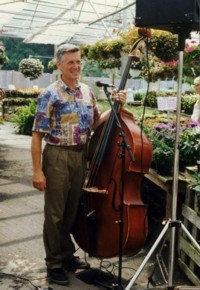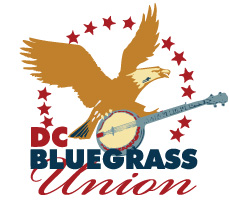by Randy Barrett

Widely considered the leading bluegrass bassist of his generation, Tom Gray was born in Chicago in 1941.
His family moved to Washington in 1948 where his father was transferred in his work for a trade association. Gray’s earliest exposure to bluegrass and old-time country music came through his babysitter, who would listen to the Grand Ole Opry on the radio when his parents were out.
After childhood music lessons on accordion and piano, Gray’s first bluegrass instrument was guitar. He then moved on to mandolin, but the deep tones of the bass soon attracted him. He listened avidly to the recordings of the Stanley Brothers, Bill Monroe and Flatt and Scruggs and was profoundly influenced by the athletic, moving bass lines of George Shuffler, John Shuffler and, later, jazz master Keeter Betts, who was also a D.C. native.
Gray’s first band was the Rocky Ridge Ramblers, populated entirely with fellow students, including Monte Monteith (who attended Western High School with Tom) on guitar, Jerry Stuart on mandolin, Bob Lindter banjo and Ron Roswell on fiddle.
The bassist joined the Country Gentlemen in 1960 Replacing Jim Cox. The lineup of Gray, John Duffey, Eddie Adcock and Charlie Waller would take bluegrass music to new heights and new audiences around the country. This dynamic configuration of players is now referred to by music historians and fans alike as “the classic Country Gentlemen.”
Gray left the band in 1964, replaced by Ed Ferris. The long hours on the road and low pay of a full-time musician had taken their toll. With a young family to feed, he resumed a career as a cartographer for National Geographic Society. Gray continued to play locally around the Washington, D.C., region in the mid and late 1960s with Benny and Vallie Cain, Buzz Busby, Leon Morris, Red Allen, Emerson and Waldron and Bill Clifton.
In 1969, Gray began attending a weekly jam session in the basement of banjoist Ben Eldridge’s house in Bethesda, MD, which attracted what would become an internationally acclaimed group of musicians, including John Duffey, Eldridge, John Starling, Mike Auldridge and Mike’s brother Dave Auldridge. The music was so good, Duffey agreed to come out of a self-imposed retirement and The Seldom Scene was born. The band’s first public gig was at the Rabbit’s Foot, a rock club in Washington, on Nov. 1, 1971.
Between 1971 and 1987, Tom Gray supplied the rhythmic engine, and quite a few bass solos, of the super group as it bridged traditional bluegrass with new songs by such non-bluegrass artists as James Taylor, Merle Haggard, and JJ Cale. Gray toured nationally and internationally with The Seldom Scene until 1986 when he left the band for other musical pursuits.
In the years after leaving The Scene, Tom has played with many bands, including Bill Clifton, Paul Adkins and the Borderline Band, the Gary Ferguson Band, Hazel Dickens Band, occasional reunions of the Classic Country Gentlemen, the Gray Green and Travers Trio, the Bluegrass Authority, the Seldom Seniors, John Starling and Carolina Star, Emmylou Harris, the Country Gentlemen Reunion Band, Lisa Kay Howard Band, Darren Beachley & the Legends of the Potomac. For 14 years, Tom played and recorded with The Federal Jazz Commission, and other traditional jazz bands.
He continues to play nationally and regionally with such bands as Eddie & Martha Adcock, Appalachian Flyer, The Newgrass Effect, Jay Armsworthy and Eastern Tradition, and Randy Barrett and the Barretones.
Tom Gray was inducted into the Bluegrass Hall of Fame in Owensboro, KY, in 1996. He still lives in Kensington, MD.
